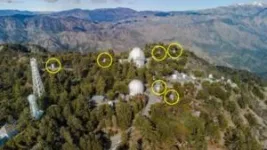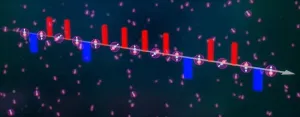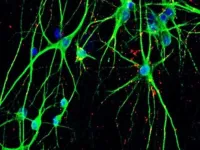(Press-News.org) ATLANTA — A new three-year, $3.5 million grant from the U.S. National Science Foundation will foster new research at Georgia State’s Center for High Angular Resolution Astronomy (CHARA) Array by astronomers from around the world.
The grant will fund open-access time at the CHARA Array through the NSF National Optical-Infrared Astronomy Research Laboratory (NSF NOIRLab). The program offers astronomers the opportunity to apply for observing time at the CHARA Array to investigate all kinds of objects in the sky. Research conducted at the array is focused on studying the astrophysical properties of stars in extremely fine detail.
“We are thrilled to host these international teams of scientists to use the facilities here at the CHARA Array,” said Gail Schaefer, director of the array. “This program brings together collaborators who can share their expertise and achieve new milestones in most areas of contemporary astronomy, and specifically to the field of stellar astrophysics.”
Georgia State’s CHARA Array interferometer at the Mount Wilson Observatory in California combines the light of six telescopes spread across the mountaintop. While the views through each telescope are relatively small, when combined, they achieve the spatial resolution of a much larger telescope. This configuration gives the CHARA Array the sharpest eyes in the world for visible and infrared wavelengths.
The six domes of the CHARA Array house individual telescopes that act together to create an equivalent as large as the entire Mount Wilson Observatory grounds.
The demand for time on the CHARA Array has been extremely high due to its significance as a resource for the international research community. With the new National Science Foundation grant, the program will make 100 nights per year available to the global research community via an application system. CHARA staff members also provide scientific and technical support to assist new users at the array.
CHARA Director and Regents' Professor of Physics and Astronomy Douglas Gies said the new funding will allow astronomers to fulfill plans to explore stars in exquisite detail.
“The National Science Foundation award is the key to open the array to the best ideas about new avenues for research,” he said. “There will be remarkable new results coming soon about stars, planets and distant active galaxies.”
It has been nearly 15 years since CHARA first offered access to the array to the general community in 2010. Initially, only a limited number of 10 nights per year were available through a trial program. Thanks to its success, CHARA has been able to expand the program for open competition through NOIRLab. To date, more than 400 astronomers have led observational programs at CHARA through the open-access program.
“CHARA runs the best optical and infrared interferometer in the world and delivers the highest resolution observations possible at these wavelengths,” said Nigel Sharp, a program director in NSF’s Division of Astronomical Sciences. “It is exciting to see that such observations can be delivered routinely and that CHARA’s sought-after capabilities are now available to non-experts in the research community.”
Already, the program has led to exciting breakthroughs including detailed images of the surfaces of nearby stars, new high-resolution images of a supermassive black hole in a distant galaxy, the first images of a nova as it exploded, the sharpest images of young planet-forming disks around stars and evidence that groups of stars can tear apart their planet-forming disk, leaving it with tilted rings.
“We anticipate significant impact through the open-application program supported by the National Science Foundation,” said Donald Hamelberg, Georgia State’s interim vice president for research and economic development. “This program not only fosters scientific collaboration but also attracts renowned scientists from across the globe to conduct groundbreaking research using the CHARA Array."
Thanks to the layout of the telescopes, the length of its baselines and the range of wavelengths covered by its beam combiner cameras, the CHARA Array is uniquely powerful for milliarcsecond imaging research. For example, the array can measure objects as small as a dime as viewed from a distance of 6,000 miles.
The CHARA Array is supported by funding from the National Science Foundation and Georgia State University through the College of Arts & Sciences and the Office of the Vice President for Research and Economic Development. For more information about Georgia State University research and its impact, visit research.gsu.edu.
Additional Contact information:
Gail Schaefer— CHARA Array Director: gschaefer@gsu.edu
Douglas Gies— CHARA Director and Regents’ Professor of Physics and Astronomy: dgies@gsu.edu
END
$3.5M grant to Georgia State will fuel space research across the globe
New funding for GSU’s CHARA Array allows astronomers to conduct research through an open-access application system.
2024-09-12
ELSE PRESS RELEASES FROM THIS DATE:
Polar molecules dance to the tunes of microwaves
2024-09-12
The interactions between quantum spins underlie some of the universe’s most interesting phenomena, such as superconductors and magnets. However, physicists have difficulty engineering controllable systems in the lab that replicate these interactions.
Now, in a recently published Nature paper, JILA and NIST Fellow and University of Colorado Boulder Physics Professor Jun Ye and his team, along with collaborators in Mikhail Lukin’s group at Harvard University, used periodic microwave pulses in a process known as Floquet engineering, to tune interactions between ultracold potassium-rubidium molecules in a system appropriate for studying fundamental magnetic ...
Quantum researchers cause controlled ‘wobble’ in the nucleus of a single atom
2024-09-12
Researchers from Delft University of Technology in The Netherlands have been able to initiate a controlled movement in the very heart of an atom. They caused the atomic nucleus to interact with one of the electrons in the outermost shells of the atom. This electron could be manipulated and read out through the needle of a scanning tunneling microscope. The research, published in Nature Communications today, offers prospects for storing quantum information inside the nucleus, where it is safe from external disturbances.
For weeks on end, the researchers studied a single titanium atom. “A Ti-47 atom, to be precise,” ...
Foods with low Nutri-Scores associated with an increased risk of cardiovascular diseases
2024-09-12
Cardiovascular diseases are the leading cause of mortality in Western Europe, accounting for 1/3 of deaths in 2019. Diet is thought to be responsible for around 30% of such deaths. Nutrition-related prevention policies therefore constitute a major public health challenge for these diseases.
In an article to be published on 11 September 2024 in Lancet Regional Health - Europe, researchers from the Nutritional Epidemiology Research Team (CRESS-EREN), with members from Inserm, Inrae, Cnam, Université Sorbonne Paris Nord and Université Paris ...
Research reveals reality of Ice Age teen puberty
2024-09-12
Landmark new research shows Ice Age teens from 25,000 years ago went through similar puberty stages as modern-day adolescents. In a study published today in the Journal of Human Evolution of the timing of puberty in Pleistocene teens, researchers are addressing a knowledge gap about how early humans grew up.
Found in the bones of 13 ancient humans between 10 and 20 years old is evidence of puberty stages. Co-led by University of Victoria (UVic) paleoanthropologist April Nowell, researchers found specific markers in the bones that allowed them to assess the progress of adolescence.
“By analyzing specific areas of the skeleton, we inferred things like menstruation ...
Use of biomarkers in the management of inflammatory bowel disease
2024-09-12
Inflammatory bowel disease (IBD), encompassing Crohn’s disease (CD) and ulcerative colitis (UC), is a chronic inflammatory disorder of the gastrointestinal (GI) tract that significantly impacts the quality of life of patients. With an incidence of approximately one in 200 individuals in developed countries and a rising trend in developing and newly industrialized nations, IBD poses a substantial burden on healthcare systems. Due to the nonspecific nature of its clinical manifestations and the lack of a gold-standard diagnostic test, managing IBD effectively remains a challenge. Therefore, reliable and widely available biomarkers ...
Powered by renewable energy, microbes turn CO2 into protein and vitamins
2024-09-12
Researchers in Germany can harvest protein and vitamin B9 from microbes by feeding them nothing much more than hydrogen, oxygen, and CO2. The technology, published September 12 in the Cell Press journal Trends in Biotechnology, runs on renewable energy to produce a sustainable, micronutrient-enriched protein alternative that may one day make it to our plates.
“This is a fermentation process similar to how you make beer, but instead of giving the microbes sugar, we gave them gas and acetate,” says corresponding author Largus Angenent of the University of Tübingen, Germany. “We knew that yeast could produce vitamin B9 on their own with sugar, however, we didn’t ...
Scientists aim to decode the genetic roots of mental illness on a large scale
2024-09-12
Neurodevelopmental and psychiatric disorders (NPD) including schizophrenia, bipolar disorder, autism, and depression are detrimental to individuals, their families and society as a whole, and in many cases still lack effective treatments. It’s becoming more and more clear that genetic mutations in certain genes can increase the likelihood of developing NPD, and several hundreds of those “risk genes” have been identified to date, but their role related to NPD remains a mystery. “Very little is known about the basic function of most of these genes, and what we do know ...
Retinopathy associated with hair dye
2024-09-12
About The Study: This case report describes a woman who presented with bilateral blurry vision a few days after dyeing her hair with hair dye containing aromatic amines.
Corresponding Author: To contact the corresponding author, Nicolas Chirpaz, MD, email nicolas.chirpaz@chu-lyon.fr.
To access the embargoed study: Visit our For The Media website at this link https://media.jamanetwork.com/
(doi:10.1001/jamaophthalmol.2024.3453)
Editor’s Note: Please see the article for additional information, including other authors, author contributions and affiliations, conflict of interest and financial ...
Race, social determinants of health, and the quality of diabetic eye care
2024-09-12
About The Study: This study found that certain social determinants of health affected monitoring for diabetic retinopathy similarly for Black and white patients with diabetes while others affected them differently. Patients living in rural communities, Black patients with preexisting diabetic retinopathy, and Hispanic white patients were not receiving eye care in accordance with clinical practice guidelines, which may contribute to worse outcomes.
Corresponding Author: To contact the corresponding author, Dustin D. French, PhD, email dustin.french@northwestern.edu.
To access the embargoed ...
Molecular, socioeconomic, and clinical factors affecting racial and ethnic disparities in colorectal cancer survival
2024-09-12
About The Study: This single-center cohort study identified substantial overall survival disparity and differing frequencies of driver gene variations by race and ethnicity. Socioeconomic status had the largest contribution but accounted for less than one-third of the disparity, with substantial contribution from tumor molecular features. Further study of the associations of genetic ancestry and the molecular pathogenesis of colorectal cancer with chemotherapy response is needed.
Corresponding ...
LAST 30 PRESS RELEASES:
AI offers ‘roadmap’ to plant genetics
Myosin XI-1: A key molecular target for salt-tolerant crops
Pusan National University study highlights the health hazards of ultrafine particles from small home appliances with electric heating coils and brushed DC motors
Global first: New Indigenous-led research initiative to revitalize legal orders
Transforming acoustic waves with a chip
When climate risk hits home, people listen: Study reveals key to engagement with disaster preparedness messaging
Major breakthrough against diabetes thanks to a microbial molecule that disarms inflammation
Silicon chips on the brain: Researchers announce a new generation of brain-computer interface
Getting rest is the best
Towards sustainable organic synthesis – Mechanochemistry replaces lithium with sodium in organic reactions
Wireless device ‘speaks’ to the brain with light
Greenhouse gases to intensify extreme flooding in the Central Himalayas
New study sheds light on Milky Way's mysterious chemical history
Could altering the daily timing of immunotherapy improve survival in people with cancer?
Weaving secondary battery electrodes with fibers and tying them like ropes for both durability and performance
Using social media may impair children’s attention
Science briefing: An update on GLP-1 drugs for obesity
Lower doses of immunotherapy for skin cancer give better results
Why didn’t the senior citizen cross the road? Slower crossings may help people with reduced mobility
ASH 2025: Study suggests that a virtual program focusing on diet and exercise can help reduce side effects of lymphoma treatment
A sound defense: Noisy pupae puff away potential predators
Azacitidine–venetoclax combination outperforms standard care in acute myeloid leukemia patients eligible for intensive chemotherapy
Adding epcoritamab to standard second-line therapy improves follicular lymphoma outcomes
New findings support a chemo-free approach for treating Ph+ ALL
Non-covalent btki pirtobrutinib shows promise as frontline therapy for CLL/SLL
University of Cincinnati experts present research at annual hematology event
ASH 2025: Antibody therapy eradicates traces of multiple myeloma in preliminary trial
ASH 2025: AI uncovers how DNA architecture failures trigger blood cancer
ASH 2025: New study shows that patients can safely receive stem cell transplants from mismatched, unrelated donors
Protective regimen allows successful stem cell transplant even without close genetic match between donor and recipient
[Press-News.org] $3.5M grant to Georgia State will fuel space research across the globeNew funding for GSU’s CHARA Array allows astronomers to conduct research through an open-access application system.






